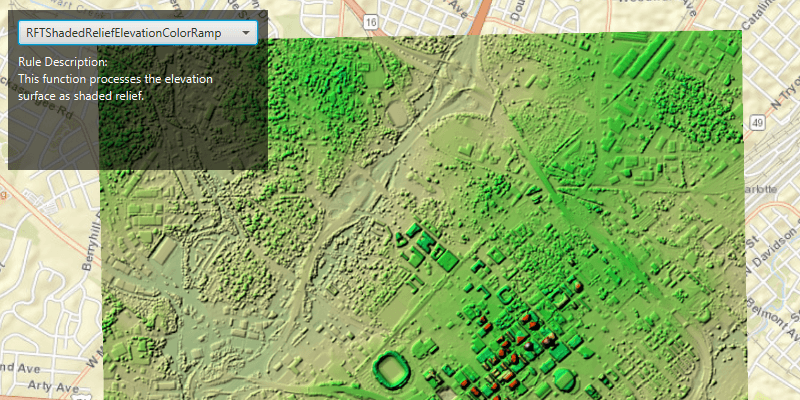Display a raster on a map and apply different rendering rules to that raster.

Use case
Raster images whose individual pixels represent elevation values can be rendered in a number of different ways, including representation of slope, aspect, hillshade, and shaded relief. Applying these different rendering rules to the same raster allows for a powerful visual analysis of the data. For example, a geologist could interrogate the raster image to map subtle geological features on a landscape, which may become apparent only through comparing the raster when rendered using several different rules.
How to use the sample
Run the sample and use the drop-down menu at the top to select a rendering rule.
How it works
- Create an
ImageServiceRasterusing a URL to an online image service. - After loading the raster, use
imageServiceRaster.getServiceInfo().getRenderingRuleInfos()to get a list ofRenderingRuleInfosupported by the service. - Choose a rendering rule info to apply and use it to create a
RenderingRule. - Create a new
ImageServiceRasterusing the same URL. - Apply the rendering rule to the new raster using
imageServiceRaster.setRenderingRule(renderingRuleInfo). - Create a
RasterLayerfrom the raster for display.
Relevant API
- ImageServiceRaster
- RasterLayer
- RenderingRule
About the data
This raster image service contains 9 LAS files covering Charlotte, North Carolina's downtown area. The lidar data was collected in 2007. Four Raster Rules are available for selection: None, RFTAspectColor, RFTHillshade, and RFTShadedReliefElevationColorRamp.
Additional information
Image service rasters of any type can have rendering rules applied to them; they need not necessarily be elevation rasters. See the list of raster function objects and syntax for rendering rules in the ArcGIS REST API documentation.
Tags
raster, rendering rules, visualization
Sample Code
/* Copyright 2019 Esri
*
* Licensed under the Apache License, Version 2.0 (the "License");
* you may not use this file except in compliance with the License.
* You may obtain a copy of the License at
*
* http://www.apache.org/licenses/LICENSE-2.0
*
* Unless required by applicable law or agreed to in writing, software
* distributed under the License is distributed on an "AS IS" BASIS,
* WITHOUT WARRANTIES OR CONDITIONS OF ANY KIND, either express or implied.
* See the License for the specific language governing permissions and
* limitations under the License.
*
*/
package com.esri.samples.raster_rendering_rule;
import java.util.List;
import javafx.application.Application;
import javafx.geometry.Insets;
import javafx.geometry.Pos;
import javafx.scene.Scene;
import javafx.scene.control.Alert;
import javafx.scene.control.ComboBox;
import javafx.scene.control.Label;
import javafx.scene.control.ProgressIndicator;
import javafx.scene.layout.Background;
import javafx.scene.layout.BackgroundFill;
import javafx.scene.layout.CornerRadii;
import javafx.scene.layout.StackPane;
import javafx.scene.layout.VBox;
import javafx.scene.paint.Paint;
import javafx.stage.Stage;
import javafx.util.StringConverter;
import com.esri.arcgisruntime.ArcGISRuntimeEnvironment;
import com.esri.arcgisruntime.arcgisservices.RenderingRuleInfo;
import com.esri.arcgisruntime.layers.RasterLayer;
import com.esri.arcgisruntime.loadable.LoadStatus;
import com.esri.arcgisruntime.mapping.ArcGISMap;
import com.esri.arcgisruntime.mapping.BasemapStyle;
import com.esri.arcgisruntime.mapping.view.MapView;
import com.esri.arcgisruntime.raster.ImageServiceRaster;
import com.esri.arcgisruntime.raster.RenderingRule;
public class RasterRenderingRuleSample extends Application {
private MapView mapView;
@Override
public void start(Stage stage) {
try {
// create stack pane and application scene
StackPane stackPane = new StackPane();
Scene scene = new Scene(stackPane);
scene.getStylesheets().add(getClass().getResource("/raster_rendering_rule/style.css").toExternalForm());
// set title, size, and add scene to stage
stage.setTitle("Raster Rendering Rule Sample");
stage.setWidth(800);
stage.setHeight(700);
stage.setScene(scene);
stage.show();
// authentication with an API key or named user is required to access basemaps and other location services
String yourAPIKey = System.getProperty("apiKey");
ArcGISRuntimeEnvironment.setApiKey(yourAPIKey);
// create a control panel
var controlsVBox = new VBox(8);
controlsVBox.setBackground(new Background(new BackgroundFill(Paint.valueOf("rgba(0,0,0,0.6)"), CornerRadii.EMPTY, Insets.EMPTY)));
controlsVBox.setPadding(new Insets(10.0));
controlsVBox.setMaxSize(260, 160);
controlsVBox.getStyleClass().add("panel-region");
// create progress indicator
var progressIndicator = new ProgressIndicator();
progressIndicator.setVisible(false);
// create drop down menu of Rendering Rules
ComboBox<RenderingRuleInfo> renderingRuleInfoComboBox = new ComboBox<>();
renderingRuleInfoComboBox.setMaxWidth(260.0);
renderingRuleInfoComboBox.setConverter(new StringConverter<>() {
@Override
public String toString(RenderingRuleInfo renderingRuleInfo) {
return renderingRuleInfo != null ? renderingRuleInfo.getName() : "";
}
@Override
public RenderingRuleInfo fromString(String string) {
return null;
}
});
// create a label for the Rendering Rule info
Label renderingRuleInfoLabel = new Label("");
renderingRuleInfoLabel.setWrapText(true);
// add the ComboBox and Label to the controlsVBox
controlsVBox.getChildren().addAll(renderingRuleInfoComboBox, renderingRuleInfoLabel);
// create a map with the streets basemap style
ArcGISMap map = new ArcGISMap(BasemapStyle.ARCGIS_STREETS);
// create a map view and set the map to it
mapView = new MapView();
mapView.setMap(map);
// create an Image Service Raster as a raster layer and add to map
String ImageServiceRasterUri = "https://sampleserver6.arcgisonline.com/arcgis/rest/services/CharlotteLAS/ImageServer";
ImageServiceRaster imageServiceRaster = new ImageServiceRaster(ImageServiceRasterUri);
RasterLayer imageRasterLayer = new RasterLayer(imageServiceRaster);
map.getOperationalLayers().add(imageRasterLayer);
// show alert if layer fails to load
imageRasterLayer.addDoneLoadingListener(() -> {
if (imageRasterLayer.getLoadStatus() == LoadStatus.LOADED) {
// zoom to extent of the raster
mapView.setViewpointGeometryAsync(imageServiceRaster.getServiceInfo().getFullExtent());
// get the predefined rendering rules
List<RenderingRuleInfo> renderingRuleInfos = imageServiceRaster.getServiceInfo().getRenderingRuleInfos();
// populate the drop down menu with the rendering rule names
renderingRuleInfoComboBox.getItems().addAll(renderingRuleInfos);
// listen to selection in the drop-down menu
renderingRuleInfoComboBox.getSelectionModel().selectedItemProperty().addListener(o -> {
// get the requested rendering rule info from the list
RenderingRuleInfo selectedRenderingRuleInfo = renderingRuleInfoComboBox.getSelectionModel().getSelectedItem();
// change the label text to the rendering rule info description
String renderingRuleInfoDescription = selectedRenderingRuleInfo.getDescription();
renderingRuleInfoLabel.setText("Rule Description: \n" + renderingRuleInfoDescription);
// clear previous raster layer from the map's operational layers
map.getOperationalLayers().clear();
// create a rendering rule object using the rendering rule info
RenderingRule renderingRule = new RenderingRule(selectedRenderingRuleInfo);
// create a new image service raster
ImageServiceRaster appliedImageServiceRaster = new ImageServiceRaster(ImageServiceRasterUri);
// show progress indicator while rule is loading
progressIndicator.visibleProperty().bind(appliedImageServiceRaster.loadStatusProperty().isEqualTo(LoadStatus.LOADING));
// apply the rendering rule
appliedImageServiceRaster.setRenderingRule(renderingRule);
RasterLayer rasterLayer = new RasterLayer(appliedImageServiceRaster);
map.getOperationalLayers().add(rasterLayer);
});
// automatically select the first rendering rule
renderingRuleInfoComboBox.getSelectionModel().selectFirst();
} else {
new Alert(Alert.AlertType.ERROR, "Error loading Image Raster Layer.").show();
}
});
// add the map view to the stack pane
stackPane.getChildren().addAll(mapView, controlsVBox, progressIndicator);
StackPane.setAlignment(controlsVBox, Pos.TOP_LEFT);
StackPane.setMargin(controlsVBox, new Insets(10, 0, 0, 10));
StackPane.setAlignment(progressIndicator, Pos.BOTTOM_CENTER);
StackPane.setMargin(progressIndicator, new Insets(10, 0, 50, 0));
} catch (Exception e) {
// on any error, display the stack trace.
e.printStackTrace();
}
}
/**
* Stops and releases all resources used in application.
*/
@Override
public void stop() {
if (mapView != null) {
mapView.dispose();
}
}
/**
* Opens and runs application.
*
* @param args arguments passed to this application
*/
public static void main(String[] args) {
Application.launch(args);
}
}